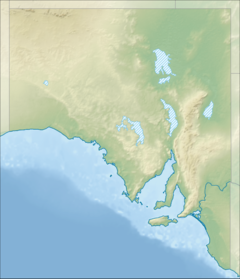The River Angas, part of the River Murray catchment, is a river that is located in the Adelaide Hills region in the Australian state of South Australia.
| Angas | |
|---|---|
 Angas River in Strathalbyn | |
Location of the river mouth in South Australia | |
| Location | |
| Country | Australia |
| State | South Australia |
| Region | Adelaide Hills |
| Towns | Macclesfield, Strathalbyn, Belvidere |
| Physical characteristics | |
| Source | Bugle Ranges, Mount Lofty Range |
| • location | Flaxley |
| • coordinates | 35°08′18″S 138°48′25″E / 35.138322°S 138.807007°E |
| • elevation | 232 m (761 ft) |
| Mouth | Lake Alexandrina |
• location | Milang |
• coordinates | 35°23′54″S 138°59′58″E / 35.398220°S 138.999450°E |
• elevation | 0 m (0 ft) |
| Length | 49 km (30 mi) |
| Basin features | |
| River system | River Murray catchment |
| [1][2] | |
Course and features
editThe River Angas arises on the eastern side of the Mount Lofty Ranges. Its headwaters are near Macclesfield and it flows generally southward through Strathalbyn, emptying into Lake Alexandrina near the town of Milang. The river descends 232 metres (761 ft) over its 49-kilometre (30 mi) course.[1]
Towns along the river include Macclesfield, Strathalbyn and Belvidere.
Etymology
editThe river was named on 31 December 1837, during the exploration by Robert Cock, William Finlayson, A. Wyatt and G. Barton from Adelaide to Lake Alexandrina. "We gave to this river the name of Angas, in honour of the chairman of the South Australian Company, whose interest in and exertions on behalf of the colony are well known."[3]
See also
editReferences
edit- ^ a b "Map of Angas River, SA". Bonzle Digital Atlas of Australia. Retrieved 25 March 2017.
- ^ "Placename Details: Angas River". Property Location Browser. Government of South Australia. 15 February 2007. SA0001439. Retrieved 17 December 2015.
- ^ Cock, Robert; Finlayson, Wm.; Wyatt, A.; Barton, G. (20 January 1838). "Journal of an excursion from Adelaide to the River Murray and Lake Alexandrina, December 1837". South Australian Gazette and Colonial Register. Adelaide.
